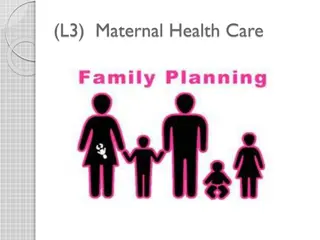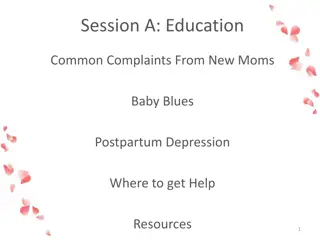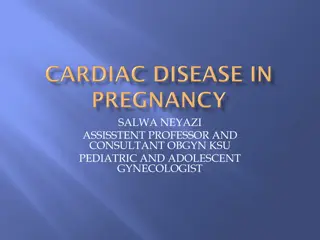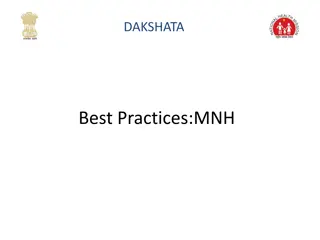Understanding Neurogenic Speech and Language Disorders in Adults
This chapter provides insight into language disorders in adults, including types of aphasia, causes such as toxins, traumatic brain injury, brain tumors, and strokes. It discusses cerebral hemorrhage, occlusive strokes, ischemic stroke, transient ischemic attacks, and cerebral thrombosis. The conten
1 views • 34 slides
Proclaiming Good News and Healing Miracles from the Book of Luke
The passages from the book of Luke narrate how the Spirit of the Lord rests on Jesus to bring good news to the poor, proclaim freedom and sight to the oppressed, and announce the year of the Lord's favor. The accounts also include miraculous healings of a woman with a hemorrhage and a young girl res
1 views • 11 slides
Progress and Challenges in PPH Prevention and Management
Presented by Michael Muthamia, the AMPLI-PPHI program aims to reduce maternal mortality by promoting the early adoption and scale-up of new PPH treatments. With a focus on heat-stable carbetocin, tranexamic acid, and misoprostol, the program drives catalytic change through evidence generation, marke
2 views • 13 slides
Combatting Postpartum Haemorrhage: Roadmap and Call-to-Action
Postpartum haemorrhage (PPH) is a significant global health concern, particularly affecting low- and middle-income countries. The need for a comprehensive roadmap and call-to-action arises from public health needs, innovation deficits, inconsistent guidance, implementation barriers, and the high mat
2 views • 17 slides
Maternal Health Care and Family Planning Overview
Maternal health care and family planning are essential components of reproductive health. Family planning helps individuals achieve various objectives like avoiding unwanted pregnancies, controlling the timing and number of children, and regulating pregnancy intervals. The health benefits include pr
0 views • 19 slides
Understanding constipation, scant feces, and alimentary tract hemorrhage in farm animals
Constipation in farm animals is characterized by decreased frequency of defecation and dry, hard feces. Scant feces are small quantities of feces, commonly seen in animals with stomach abnormalities. Alimentary tract hemorrhage can result from various causes, including ulcers and infestations. Hemor
1 views • 12 slides
Clinical Update on Management of Spontaneous Intracerebral Hemorrhage
This clinical update, adapted from the 2022 guideline by the American Heart Association and American Stroke Association, covers a comprehensive range of topics related to the management of patients with spontaneous intracerebral hemorrhage. It includes information on population health implications,
0 views • 38 slides
Management of Postpartum Patient with Persistent Tachycardia and Dizziness
A 33-year-old African American female at 39 weeks of gestation, G4P3, with possible ITP and anemia, was admitted for induction. Following delivery, her vital signs and labs were stable initially, but she developed persistent tachycardia and mild dizziness postpartum. After transfusion and monitoring
0 views • 19 slides
Developing Cardiovascular Screening Measures for Pregnant and Postpartum Women Project
Cardiovascular disease (CVD) is a leading cause of maternal mortality in the US, with disparities in morbidity. Standardizing evaluation and triage is crucial. Preventability studies show a high potential for identifying at-risk cases. The CVD Toolkit aims to enhance awareness and readiness among he
1 views • 17 slides
Maternal and Fetal Complications of Obesity in Pregnancy
Understanding the impact of obesity stigma as a stressor throughout the lifecourse is essential, especially concerning pregnancy. The prevalence of pre-pregnancy overweight and obesity poses significant risks, leading to various maternal complications like gestational diabetes, cesarean delivery, an
0 views • 62 slides
Understanding Postpartum and Baby Blues: Education and Support
Providing new moms with essential information on postpartum adjustment, baby blues, and available resources to cope with challenges. Session goals include establishing a supportive relationship, setting realistic expectations, and introducing role transitions. Expectations, views on motherhood, and
0 views • 20 slides
Understanding Cerebral Edema: Causes, Treatments, and Pathophysiology
Cerebral edema is a life-threatening condition that can result from various factors such as trauma, infarction, hemorrhages, or tumors. This condition can lead to increased morbidity and mortality due to hemorrhage or herniation. New advances in understanding the pathophysiology of cerebral edema ha
1 views • 28 slides
TCCC Critical Decision Case Studies: Bleeding Management Scenario
This presentation focuses on a critical decision case study in Tactical Combat Casualty Care (TCCC) involving a casualty with high amputations and ongoing massive hemorrhage. The scenario explores the challenges of managing uncontrolled bleeding in a combat situation and provides insights into the r
0 views • 139 slides
Understanding Determinants of Maternal Death: Causes, Factors, and Response
This educational session delves into the determinants of maternal death, distinguishing between causes and factors that increase the risk of maternal mortality. It covers possible determinants like hemorrhage, sepsis, and poor access to healthcare services, and discusses the Three Delays model for i
0 views • 18 slides
Anesthesia Management for Post-Tonsillectomy Hemorrhage in Children
This article discusses the epidemiology, causes, and anesthesia management of post-tonsillectomy and adenoidectomy hemorrhage in children. It covers the rates of hemorrhage following these procedures, including primary and secondary occurrences, mortality statistics, and specific factors contributin
0 views • 31 slides
Managing Complications in Postpartum Period: Puerperal Sepsis Overview
Puerperal sepsis, a leading cause of maternal death, can be prevented through hygiene practices and early identification. Learn about the risk factors, diagnosis, and prevention strategies for maternal sepsis in the postpartum period.
3 views • 9 slides
Detection of Low-Grade Hemorrhages in Preterm Infants: Ultrasounds vs. MRIs
This study compares the effectiveness of head ultrasounds and brain MRIs in detecting low-grade hemorrhages in preterm infants. It discusses the incidence of intraventricular hemorrhage (IVH) in very low birth weight infants, classification of IVH, risk factors for IVH, outcomes related to IVH grade
9 views • 33 slides
Understanding Maternal Mental Health Complications
Maternal mental health complications, including postpartum depression and psychosis, can have a significant impact on both the mother and child's well-being. Factors such as stigma, culture, trauma, and lack of support systems can exacerbate these conditions. Early detection and intervention are cru
0 views • 12 slides
Treatment Strategies for Hemorrhagic Stroke: Goals and Management
Short-term goals for treating hemorrhagic stroke involve rapid neurointensive care to maintain adequate oxygenation, breathing, and circulation, along with managing increased intracranial pressure and blood pressure. Long-term management focuses on preventing complications, recurrent bleeding, delay
11 views • 9 slides
Comparing Bleeding and Mortality Risks of Dabigatran vs. Rivaroxaban in Elderly Medicare Beneficiaries
A study by DJ Graham et al. compared the risks of stroke, bleeding, and mortality in elderly Medicare beneficiaries with nonvalvular atrial fibrillation treated with dabigatran or rivaroxaban. The study included over 118,000 patients and found that dabigatran was associated with a lower risk of majo
0 views • 9 slides
Medicaid Coverage for Postpartum Women and Doulas - Learning Session Overview
Explore how state Medicaid programs are extending postpartum coverage for women beyond the standard 60-day period and paying for doula services. Learn about current policies, options for coverage extensions, and legal mechanisms at the state level. Discover efforts to improve maternal health outcome
0 views • 16 slides
Managing Blood Sugar Levels During Pregnancy and Postpartum
This helpful guide by Dr. Donna D. Johnson provides detailed insights on managing blood sugar levels for women with gestational diabetes mellitus (GDM), type 2 diabetes, and type 1 diabetes during pregnancy and postpartum. It covers medication adjustments, monitoring criteria, and specific recommend
0 views • 8 slides
Postpartum Support and Education Sessions
Providing a supportive environment for postpartum mothers, these sessions cover topics like setting expectations, motherhood views, baby blues, postpartum depression, seeking support, and importance of assistance. Emphasizing the need for positive support, the sessions aim to equip women with skills
0 views • 35 slides
Lumbar Puncture: Indications, Contraindications, and Post-procedure Considerations
Lumbar puncture is a medical procedure involving the insertion of a needle into the spinal subarachnoid space to collect cerebrospinal fluid for diagnostic or therapeutic purposes. Indications for performing a lumbar puncture include suspicion of meningitis, subarachnoid hemorrhage, CNS diseases lik
0 views • 17 slides
Understanding Cardiovascular Changes in Pregnancy
This informative content discusses the normal physiological changes of the cardiovascular system in pregnancy, symptoms and signs of cardiovascular disease, the impact of pregnancy on cardiovascular health, and the management of cardiovascular issues during pregnancy, labor, and the postpartum perio
0 views • 28 slides
Understanding Avian Influenza: Symptoms, Diagnosis, and Prevention
Avian influenza, or bird flu, is a viral disease affecting birds' respiratory, digestive, and nervous systems. It presents in two forms - Highly Pathogenic Avian Influenza Virus (HPAIV) and Low Pathogenic Avian Influenza Virus (LPAIV). The virus has two important surface antigens, Hemagglutinin (H)
0 views • 7 slides
Understanding Postpartum Relationship Challenges and Communication Strategies
Explore common relationship challenges faced by postpartum women, including issues with partners, extended family, and the relationship with the infant. Learn effective communication tips and strategies to navigate these challenges, maintain emotional intimacy, and seek help when needed.
0 views • 30 slides
Understanding Peptic Ulcers: Causes, Symptoms, and Nutritional Management
Shahid Virpatni Laxmi Mahavidyalaya conducted a presentation on gastrointestinal (GI) disorders, focusing on peptic ulcers. The content covers the etiology, symptoms, and nutritional management of peptic ulcers, emphasizing the importance of proper diet in managing this condition. Peptic ulcers, cha
0 views • 8 slides
**Understanding Portal Hypertension: Causes, Symptoms, and Treatment**
Portal hypertension is a serious condition often associated with cirrhosis. Causes include cirrhosis and non-cirrhotic conditions. Symptoms range from asymptomatic to complications like variceal hemorrhage, ascites, and splenomegaly. Preventive measures, such as nonselective beta-blockers, are cruci
0 views • 14 slides
Postpartum Hemorrhage Simulation Activity with Swim Lane Mapping
Prepare for a postpartum hemorrhage simulation activity by printing slides, setting up a floor diagram with masking tape lanes, and arranging role members. Watch instructional videos, analyze contributing factors, and place process steps on the diagram. Follow key instructions, identify key actions
0 views • 20 slides
Postpartum Care and Physiologic Changes: A Comprehensive Guide
Explore the normal physiologic changes and components of postpartum care, including reproductive and urinary tract changes, gastrointestinal adjustments, cardiovascular modifications, and psychosocial considerations. Learn about managing postpartum issues like hemorrhoids, stress urinary incontinenc
0 views • 11 slides
Comprehensive Healthcare Benefits Overview
Explore a wide range of healthcare services including family planning, prenatal care, screenings, STD testing, and postpartum services under HIP, MAMA, and Hoosier Healthwise programs. Services cover various aspects of sexual health, pregnancy care, labor & delivery, and postpartum support with a fo
0 views • 18 slides
Surrey-North Delta GDM Provider Survey Data Summary
This document summarizes data collected from 69 healthcare providers in Surrey-North Delta regarding postpartum care for Gestational Diabetes Mellitus (GDM) patients. It includes provider characteristics, topics discussed during postpartum visits, providers' actions regarding patient care, confidenc
0 views • 5 slides
Medication-Assisted Treatment in Intrapartum and Postpartum Care
Explore guidelines for medication-assisted treatment during intrapartum and postpartum periods, emphasizing pain management strategies for opioid-dependent patients. Tips include adjusting dosages, adding NSAIDs, and considering opioid agonists with high mu receptor affinity. Careful monitoring and
0 views • 12 slides
Managing Postpartum Psychosis: A Case Study
Cynthia, a new mother, believes her baby, Damien, is possessed by the devil. She expresses delusions and hallucinations, prompting concern for postpartum psychosis. Her history, symptoms, and risk factors need careful evaluation by a psychiatrist to ensure proper management.
2 views • 13 slides
Anesthesia Management for Post-Tonsillectomy and Adenoidectomy Hemorrhage
This content provides insights into the epidemiology of post-tonsillectomy and adenoidectomy hemorrhage in children, including rates and causes. It outlines a plan for anesthesia management, covering preoperative, intraoperative, and postoperative aspects. Mortality statistics after tonsillectomy an
0 views • 31 slides
Best Practices for Maternal and Newborn Health (MNH) - Essential Guidelines
Comprehensive guidelines for maternal and newborn health practices include dos and don'ts, such as perineal shaving, delayed cord clamping, exclusive breastfeeding, and more. Key measures like controlled cord traction (CCT) in a relaxed uterus and delaying the baby's first bath play crucial roles in
0 views • 11 slides
Overview of Pulmonary Hemorrhage in Infants
Pulmonary hemorrhage in infants is a severe condition characterized by bloody discharge from the upper respiratory tract or endotracheal tube, often associated with prematurity, lung complications, infections, or trauma. The etiology, pathophysiology, clinical manifestations, and diagnosis of pulmon
0 views • 14 slides
Guidelines for HIV Testing During Pregnancy and Postpartum
These guidelines recommend HIV testing during pregnancy, at delivery, and postpartum. Testing should be done early in pregnancy and again in the third trimester. Expedited testing during labor is required for certain patients, and syphilis testing is recommended. Pre-exposure and post-exposure proph
0 views • 18 slides
Emergency Management in Cardiac Intensive Care
Information on managing emergencies in cardiac intensive care including topics like hemorrhage post-cardiac surgery, tamponade post-cardiac surgery, and control of bleeding. Details on initial steps for bleeding control, teamwork in managing hemorrhage, and diagnosing tamponade post-cardiac surgery
0 views • 16 slides







































